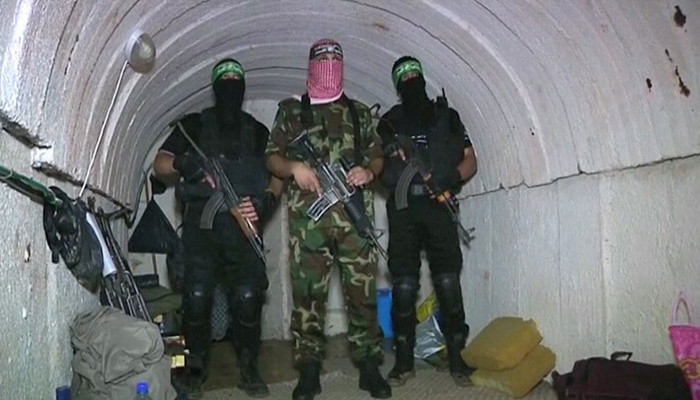
Intelligence shared with the United States indicates that a group of Hamas operatives, over a span of two years, used a network of hardwired phones integrated into the tunnel system beneath Gaza to plan the unexpected and deadly attack on Israel, two reliable sources have revealed. This sheds light on why Israel and the US were caught off guard by the Hamas attack.
Hamas concealed the planning of the operation through traditional counter-intelligence methods, the intelligence shared by Israel with US officials reveals. This involved holding in-person planning meetings and avoiding digital communications, which could be tracked by the Israelis, in favour of using hardwired phones in the tunnels.
In the course of these two years of planning, they refrained from using computers or cell phones throughout the two-year planning period to avoid detection by the Israeli or US intelligence, the sources told a media house. The small, tightly knit cell operating within the tunnels utilized hardwired phone lines for communication and strategy development.
These phone lines within the tunnels enabled the operatives to maintain covert communication among themselves, ensuring that the Israeli intelligence authorities could not track their activities, the sources added. There was limited discussion, minimal exchange of information, and coordination beyond the immediate vicinity.
They maintained a low profile until the time came to activate and mobilize hundreds of Hamas fighters for the attack on October 7, when approximately 1,500 fighters crossed into Israel, resulting in at least 1,400 Israelis being killed. Despite receiving a series of strategic warnings from US and Israeli intelligence agencies, officials from both countries were not able to foresee the events of October 7.
The Israel Defense Forces (IDF) commonly refers to the tunnels constructed by Hamas over the past approximately fifteen years as the ‘Gaza Metro’. These tunnels form an extensive labyrinth used for storing rockets and ammunition caches and serving as a covert means for militants to move undetected. Additionally, the IDF asserts that this network includes critical Hamas command and control centres.
Assessing the scope of the ‘Gaza Metro’ network in Israel is an extremely challenging task. This complexity arises from its presumed existence beneath a region where Gaza spans only 41 kilometres in length and 10 kilometres in width.
In the aftermath of the 2021 conflict, the IDF stated that it had obliterated over 100 kilometres of tunnels through airstrikes. In contrast, Hamas claimed that its tunnel network extended for 500 kilometres and only 5% of them were impacted. To put these numbers in perspective, the London Underground, which is mostly above ground, is approximately 400 kilometres long.
Tunnel construction in Gaza commenced before Israel withdrew its troops and settlers in 2005. However, it significantly escalated after Hamas assumed control of the Strip two years later, leading to increased security measures by Israel and Egypt, restricting the movement of goods and people in and out. After being kidnapped, Yocheved Lifshitz, an 85-year-old grandmother who was one of two hostages released by Hamas on Monday, was taken into a network of tunnels where she slept on a mattress placed on the tunnel floor.
According to sources familiar with the Hamas assault, the small, tightly knit cell held off on briefing a larger group of fighters above ground for the specific operation until just before the attack was launched. One of the sources mentioned that, even though ground unit commanders and fighters had undergone training for several months and were in a state of general preparedness, they were informed of the precise plans only in the days leading up to the operation.
“That’s how you maintain strict compartmentalization,” the sources added, emphasizing that a similar approach was employed in this situation. One of the sources mentioned that, while some of the training activities above ground were noticed, they did not raise significant concerns as it was thought to be routine training of individuals.
Iran has been assisting Hamas in refining their operational security tactics over time. However, according to a third source, US intelligence does not believe that Iran directly participated in planning the October 7 attack.
Israel is thought to have had prior knowledge that Palestinian militants had been utilizing hardwired communication systems before the October attack, but did not give it sufficient credence to prevent the October 7 attack. During an Israeli military operation, called ‘Operation Home and Garden’, in the city of Jenin in the northern West Bank this summer, Israeli troops encountered what seemed to be a comparable communication system.
They found secure, hardwired communication lines and closed-circuit surveillance cameras that provided early notice of Israeli troop movements, an Israeli official described. The IDF then announced it had targeted a joint operational command centre in Jenin employed by militant cells that was utilized for “advanced observation and reconnaissance” and acted as a focal point for coordination and communication among the terrorists. (IPA Service)
(The author is a Defence, Aerospace & Political Analyst based in Bengaluru.)
The post How Hamas’ Militants Successfully Hoodwinked Israelis By Using Hardwired Phones? first appeared on Latest India news, analysis and reports on IPA Newspack.


